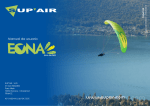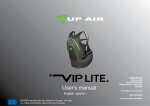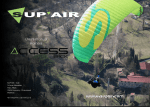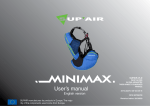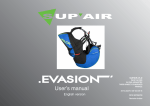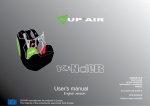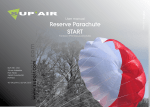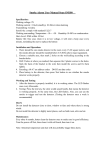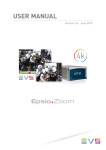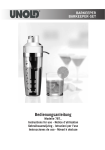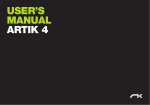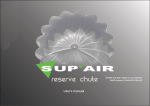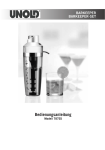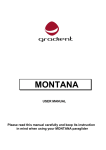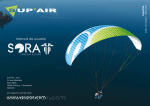Download User`s manual
Transcript
English Revision index : 24/03/2015 EONA glider user’s manual User’s manual EN-A GLIDER SUP’AIR - VLD 34 rue Adrastée Parc Altaïs 74650 Annecy - Chavanod FRANCE 45°54.024’N / 06°04.725’E SUP’AIR _EONA Page 1 EONA glider user’s manual Thank you for choosing to fly our EONA to paraglide with. We are delighted to have you on-board to share our passion for paragliding. SUP’AIR has been designing producing and selling accessories for free flying activities since 1984. By choosing a SUP’AIR product you benefit from almost thirty years of expertise, innovation and customer care. We pride ourselves for our work ethics and customer care. We hope you will find this user’s manual comprehensive, explicit and hopefully enjoyable as well. We advise you to read it carefully. You will find the latest information and updates on this product on our website : www.supair.com. If however you have any further questions, do not hesitate to ask one of our dealers. Naturally the entire SUP'AIR team remains at your disposal at [email protected] We wish you many safe and enjoyable flying hours and happy landings. Team SUP’AIR SUP’AIR _EONA Page 2 EONA glider user’s manual Introduction Technical specifications Equipment overview Connecting the glider Pre-flight preparation Take-off Flight characteristics End of the flight Specific practices Fast descents Flight incidents Line layout Materials Measurement table Certificates Maintenance Mandatory checks Warranty Disclaimer Pilot equipment Complementary equipment / Accessories Contents 4 5 6 7 9 10 11 12 12 13 15 16 17 18 22 25 26 26 26 26 27 SUP’AIR _EONA Page 3 EONA glider user’s manual Introduction Welcome to the world of free flying : a shared world of passion. The EONA wing is a glider meeting all the students and instructors requirements. It was designed for both intensive schooling and private use while providing great inflight comfort all along the pilot's progression curve. The well though out design and choice of materials were guided by the same quality and longevity objectives. The EONA glider is EN EN 926 -1 : 2006 & 926 - 2 : 2013 Classe A. Certified. Meaning that this paragliding wing has a maximal passive safety margin built-in in addition to being forgiving and collapse resistant in turbulent aerology. It is naturally adapted to all flying levels including beginner pilots. It can be used with most harnesses found on the market today. For better inflight comfort and sensations we will advise you to choose the SUP'AIR progression harness models. After reading this manual we advise you to inflate & check your wing on a training hill first. N.B. : The following three icons will help you to read this manual. Advice Caution ! Danger !! SUP’AIR _EONA Page 4 EONA glider user’s manual Glider EONA Cell number Flat surface area (m²) Span (m) Chord (m) Flat Aspect Ratio Projected surface area (m²) Projected span (m) Projected aspect ratio Glider weight (kg) In-flight weight range (kg) Trim speed (km/h) Max. speed (km/h) Certification Riser number. Trimmer Colour code WINTER Technical data XS 41 20 9.8 2.48 4.8 16.98 7.71 3.5 4.5 50-73 S 41 23 10.51 2.66 4.8 19.53 8.27 3.5 4.8 65 - 85 M 41 26.5 11.28 2.86 4.8 22.50 8.88 3.5 5.1 80 -105 L 41 29.45 11.89 3.01 4.8 25.00 9.36 3.5 5.5 100 - 130 38 49 EN A EN A EN A EN A 3 no 3 no 3 no 3 no Colour code SPRING Colour code SUMMER SUP’AIR _EONA Page 5 EONA glider user’s manual Equipment overview 5 2 1 4 14 10 3 11 9 8 7 3 12 17 16 15 19 17 18 13 20 6 1 Leading edge 2 Trailing edge 3 Stabilizer 4 Intrados 5 Extrados 6 A riser 7 A' riser (for big ears) 8 B riser 9 C riser 10 Brake line 11 Brake holding guide 12 Brake handle 13 Riser hook-up loop 14 « Ears » kit 15 BIRD 100 lt. capacity carrying rucksack. 16 Accelerator/Speedbar. 17 Accelerator/Speedbar Split-hook. 18 Accelerator/Speedbar bar. 19 Inner bag. 20 Pocket with repair kit. SUP’AIR _EONA Page 6 EONA glider user’s manual Opening the wing Connecting the glider Choose a flat or lightly angled training hill without obstacles or wind. Open your wing and arrange it in a crescent shape. Check the fabric and the lines for any sign of wear or damage. Check for the links connecting the lines to the risers to be fully closed. Identify, separate and arrange the A,B.C, risers as well as the brake lines neatly. Knots or tangles can not be present. Choosing an adapted harness. The EONA glider was certified EN A with a EN1651 & LTF certified harness and hence can be flown with most harnesses models found on the market today. We wil advise you to choose a EN1651 and or LTF certified harness with a built-in dorsal protection system. Connecting the wing to the harness. Without twisting the risers, connect them to the harness connection loops using the selflocking carabiners. Check for the risers to be properly positioned and untwisted. The "A" risers must be located at the front and facing the flight direction( see schematic ). Lastly, check for the main self-locking carabiners to be fully closed and locked in place. Harness chest strap spacing It is advised to adjust the harness's chest strap width based on your wing size : 38 cm for an EONA size XS 40 cm for an EONA size S 42 cm for an EONA size M 44 cm for an EONA size Installing the accelerator Install the accelerator according to your harness manufacturer's recommendations. Connect it to the wing using the split hooks. Once the accelerator/speedbar is connected, adjust its length according to your measurements. For correct use, there must not be any tension at the split-hook level when the accelerator/speedbar line is relaxed. Risers Red : left riser Self-locking Carabiners Green : right riser Harness : Flight direction SUP’AIR _EONA Page 7 EONA glider user’s manual Brake line length fisherman's knot Connecting the glider Brake line lengths are set at the factory to allow optimal glider control. However, if they do not suit you they can be adjusted to your liking. We will advise using a fisherman’s knot and to keep your length changes to a minimum (approx 5cm maximum). If you modify the original default setting, have it inspected and approved by a professional before flying.. The default factory maximum brake line length is : 72 cm Margin Be certain to adjust and leave a small amount of line slack to keep steering toggle play, prevent wing profile deformation and hinder the accelerator functionality. During acceleration, the glider's trailing edge must not be deformed. SUP’AIR _EONA Page 8 EONA glider user’s manual PRE-FLIGHT PREPARATION The EONA glider was designed to help new pilots with their progression. To discover your new wing, we will advise you to conduct your first small flights in calm conditions on a school training hill or a familiar site you are used to flying with your own harness. Unfold the glider and place it on its upper surface in an arc. Separate the A,B,C risers and the brakes, be certain for the risers and lines not to have any twists or knots or be hooked to a branch, stone etc... Caution ! It vital to conduct a thorough pre-flight check and have the harness properly connected to the glider prior each takeoff. Run through the following procedure prior each takeoff: - - - - - - - harness or carabiners do not show signs of wear and tear. the reserve parachute container is correctly closed and that the handle is in the correct position your personal settings have not been changed The wing is properly connected to the risers with all links securely tightened and locked in place. The wing is properly connected to the harness without any riser twist. You are securely connected to the harness with the leg and chest strap buckles closed, self-locking carabiners locked. Your are wearing your helmet and it is properly fastened. SUP’AIR _EONA Page 9 EONA glider user’s manual Take-off The design team has strived to produce a wing with optimum inflating abilities in all flyable conditions. Whether it be in light or high winds you will enjoy its docile behavior while launching. However before the first flight, practice ground-handling to become familiar with your new glider. It is possible to inflate in a front- or reversed-launch method. Forward launch To inflate the glider grab the upper ends of the "A" risers with your hands and progressively move foreward guiding the glider upward. Once the wing is flying overhead, apply brakes as necessary, look up and perform a visual check before accelerating to take off. Reverse launch If the wind speed is sustained and permits it, we will advise you to use a reversed inflation method more adapted to conduct a better visual check. Face the wing and grab the "A" risers. With a light pull and adapted rearward walking motion, inflate your wing. Once the glider is stable overhead, turn around, look up once more to check that all is ok. before running down the slope and takeoff. Note: it is not necessary to use the "A" risers to inflate the wing. Caution ! Before take-off, ensure for the airspace to be clear in front, around and above you with weather conditions matching your flying skill level.. SUP’AIR _EONA Page 10 EONA glider user’s manual FLIGHT CARACTERISTICS Here are a few tips to take advantage of your EONA wing's performance in flight: « Hands up » speed or trim speed Flying « hands up » will provide the best glide ratio in nil wind. Using the accelerator/speedbar. According to the EN A norm, the EONA glider was designed to be stable throughout its speed range. Accelerated, the wing becomes more sensitive to turbulence. If you sense a glider internal pressure decrease while pushing on the accelerator; lessen the speedbar tension to bring it back to its neutral default setting while slightly applying a small amount of brake by pulling the hand toggles and prevent a possible leading edge frontal collapse. The accelerator/speedbar length travel is: 13 cm. Piloting without the toggles/brakes. If for whatever reason, the toogles/brakes are no longer available, you will need to pilot your wing using the harness and "C" risers instead. Beware not to overcontrol the glider to limit the risk of experiencing a possible stall. To land, let your wing glide for as long as possible before applying a full braking motion. Braking using the "C" risers is not as efficient as using the toggles and could bring a more energetic landing than normal. Turns To make your glider turn efficiently, and only after checking that the space below you is clear and safe to land on, weight shift toward the inside of the turn and progressively pull your brake/toggle on the same side until the desired turning angle is reached. The turning speed and radius can also be adjusted by using the other brake/toggle controlling the upper half side of the wing. If flying at low speed, begin your turn by raising your hand on the upper and external side of the turn to prevent a possible flat-turn or twisted turn on the vertical axis. SUP’AIR _EONA Page 11 EONA glider user’s manual End of the flight Landing Be certain to always have enough altitude for a safe landing before approaching the chosen Landing Zone ( PTU, PTS, etc...). Never make aggressive maneuvers close to the ground. Always land into the wind ( upwind ), standing up and ready to run to a stop if necessary. Make your landing approach with maximum air speed if possible depending on the weather conditions of the moment, then progressively brake to slow the glider to a final touchdown. Beware not to brake too much, too soon and too rapidly to prevent a possible stall and hard landing. In case of a landing in sustained higher wind speeds, you will need to quickly turnaround, face the wing, move forward while braking down symmetrically. You can equally pull the "C" risers down to deflate the glider and bring it to the ground. Folding Fold each side of your wing in an accordion-like shape. Stack-up the leading edge reinforcements on top of one another. Bring one side of the glider over the other while keeping the leading edge reinforcements flat. Roll the wing on itself, starting from the leading edge toward the trailing edge. During the entire packing procedure, do not bend the leading edge's reinforcements. Towing Specific usage The EONA wing can be towed up. Fly only with certified gear operated by qualified personal and only after taking a towing clinic. The towing force must correspond to the weight of the equipment, and the pulling sequence can only start when the wing is fully inflated and stable over the pilot's head. Aerobatics The EONA wing was not designed to enter aerobatic maneuvers. We highly discourage its use for this type of flying. Tandem The EONA wing was not designed for tandem flying. SUP’AIR _EONA Page 12 EONA glider user’s manual FAST DESCENTS The following techniques should only be used in emergencies and require prior training to be safely conducted. Appropriate analysis and anticipation of the conditions will often prevent the need to use fast descent techniques. We will advise you to practice in still air and preferably above water. Big Ears Pulling "ears" increases the glider sink rate. We do not recommend the use of big ears close to the ground In order to pull "ears", grab the specific riser (outer "A" riser) while keeping the toggles in hands and lowering them until the win tips collapse. It is preferable to collapse one side after the other and not simultaneously in order to prevent an eventual frontal collapse. Once the "Ears" are folded and stabilized, we will recommend using the accelerator/speedbar to regain your initial air speed. To reopen the "Ears", bring the accelerator/speedbar back to its neutral default setting, then let go the risers symmetrically. You can pump the brake/toggles on either side of the wing to facilitate its reopening sequence. SUP’AIR _EONA Page 13 EONA glider user’s manual Fast descents B-line stall This technique is usually physically demanding and will provoke a parachutal wing configuration and hence wing control will be diminished. Loosing altitude using the "B" risers is done by grabbing the risers at the metal links level and applying a symmetrical downward vertical pull until the wing's profile is deformed. This maneuver can be maintained to increase the wing's sink rate. To regain a normal flying configuration, bring your hands up progressively to the "A" risers red markers, then let go the "B" risers altogether. The wing will experience a moderate surge forward which will need to be instantly neutralized and controlled. 360° spiral dives To begin a spiral dive make sure the air space is clear around and below you, then lean toward the chosen side while gradually applying brake/toggle pressure on that side. The wing will gradually accelerate before entering a full spiral dive. You may use the outer/upper toggle to manage your sink rate. In order to exit the rotation, get back to a neutral (centered) position in the harness and gradually release the inside brake. You need to keep the glider in a turn as it decelerates in order to limit the surge while exiting the spiral. If your exit is too radical the glider will surge aggressively and experience a substantial dive to be immediately controlled.. Gradually slowing down the rotation with the outside and upper brake will allow you to exit the spiral in a controlled manner. To prevent stressing we do not recommend combining spiral dives with "Ears". Conforming to the EN A, the EONA glider does not show any tendency to stay in a locked spiral configuration and will return by itself to a normal flying angle in less than two full rotations when the toggles/brakes are brought back up. DANGER This manœuvre places a lot of stress on the glider. The high speed and "G" force might be disorientating and, in extreme cases, cause you a temporary loss of consciousness. Practice this maneuver gradually with ample space around and below you. SUP’AIR _EONA Page 14 EONA glider user’s manual Asymmetric collapses Flight incidents Any paraglider may occasionally collapse due to turbulence or a piloting error. In the event of an asymmetric collapse your priority must be to stay clear of the terrain and regain level flight. It is done by via of weight shifting toward the open side and if necessary, support the action by applying an appropriate amount of brake on the same side. If the collapsed side does not automatically reopen then pump the collapse side deeply and repetitively to repressurize the deflated wing tip. Repeat if necessary until full reinflation is successful. In the event of a “cravat” (where the wing tip is snagged between the lines) you may use the "ears" technique described above by pulling on the tangled line in order to release the wingtip. Front collapses During a front collapse according to the certification standard the glider is designed to reopen on its own. make sure you do not brake to facilitate the return to a normal flight. Parachutal stall Even though this configuration only rarely occurs, you may find yourself in a situation called "parachutal stall " where the glider descends vertically with no forward motion. If it happens, release the brakes/toggles fully and trims symmetrically. You might also need to push forward on the "A" risers. Make sure you regained a normal flight configuration before proceeding with brake/toggle usage again. Stall This technique is not recommended as it requires intense physical impute. It is not a safe descent technique. Spin / asymetric stall A spin will only occur because of a piloting error. If so, release the brake fully on the stalled side and be certain to keep the glider in check during the ensuing dive and reopening sequence. SUP’AIR _EONA Page 15 EONA glider user’s manual LINE LAYOUT DIAGRAM SUP’AIR _EONA Page 16 EONA glider user’s manual Materials Fabrics Outer surface Inner Surface Supported ribs Compression straps and D ribs Unsupported ribs Rib reinforcements Producer Porcher Sport Porcher Sport Dominico tex Dominico tex Dominico tex Porcher Sport Main lines Top cascade Upper middle cascade Lower cascade Liros Liros Edelrid Reference DSL 70 PPSL 160 / PPSL 120 A7343-280 Producer Liros Liros Edelrid Brake lines Top cascade Upper middle cascade Lower middle cascade Lower cascade Mailons Skytex 38 Universal – 9017E25 Skytex 38 Universal – 9017E25 Dominico 30D hard finish Dominico 30D hard finish Dominico 30D hard finish SR 170 Producer Stabilo lines Top cascade Middle cascade Lower cascade Reference DSL 70 DSL 70 A6843-160 Producer Liros Liros Liros Edelrid Peguet Reference Reference DSL 70 PPSL 120 PPSL 160 785ox - 240 MAILLON RAPIDE DELTA INOX 3.5MM SUP’AIR _EONA Page 17 EONA glider user’s manual Maintenance sheet. EONA glider Size XS Line Check Maintenance Sheet Centre Stabilizers Wingtip 1 2 3 4 A 5667 5618 5610 5640 B 5590 5542 5533 5562 C 5655 5605 5594 5627 D 5771 5719 5707 5741 Frein 6400 6218 6097 6084 5 6 7 8 9 5636 5594 5588 5578 5629 5547 5509 5510 5504 5558 5591 5552 5556 5553 5614 5702 5657 5651 5647 5711 5943 5874 5855 5892 5832 10 11 5477 5402 5501 5436 5533 5475 5606 5543 5799 5871 12 13 14 15 16 17 5368 5314 5268 5262 5084 4971 5412 5369 5331 5326 5055 4996 5460 5426 5397 5400 5133 5036 5521 5861 5130 Tolerance: 10 mm. Riser length : 460mm Tolerance: +/- 5mm SUP’AIR _EONA Page 18 EONA glider user’s manual Measurement table EONA glider Size S Line Check Maintenance Sheet Centre Stabilizers Wingtip 1 2 3 4 A 6084 6033 6025 6057 B 6003 5952 5944 5976 C 6074 6021 6009 6045 D 6197 6141 6130 6167 Frein 6779 6601 6488 6484 5 6 7 8 9 6061 6018 6011 6001 6055 5966 5926 5928 5923 5981 6016 5976 5980 5978 6043 6135 6087 6082 6078 6147 6347 6274 6254 6295 6219 10 11 5896 5816 5917 5849 5954 5893 6034 5966 6168 6225 12 13 14 15 16 17 5780 5722 5673 5666 5457 5335 5823 5777 5737 5730 5425 5362 5877 5841 5809 5812 5508 5405 5944 6206 5505 Tolerance: 10 mm. Riser length : 460mm Tolérence +/- 5mm SUP’AIR _EONA Page 19 EONA glider user’s manual Measurement table EONA glider Size M Line Check Maintenance Sheet Centre Stabilizers Wingtip 1 2 3 4 A 6535 6481 6472 6508 B 6445 6391 6381 6417 C 6530 6475 6466 6504 D 6672 6613 6603 6644 Frein 7347 7157 7035 7032 5 6 7 8 9 6529 6483 6479 6469 6528 6434 6393 6394 6389 6452 6506 6463 6467 6465 6535 6646 6595 6586 6582 6657 6889 6812 6792 6836 6752 10 11 6364 6279 6399 6326 6462 6396 6550 6478 6697 6759 12 13 14 15 16 17 6241 6180 6127 6120 6049 5902 6298 6246 6203 6197 5976 5913 6379 6338 6305 6308 6059 5944 6459 6739 6037 Tolerance: 10 mm. Riser length : 490mm Tolérence +/- 5mm SUP’AIR _EONA Page 20 EONA glider user’s manual Measurement table EONA glider Size L Line Check Maintenance Sheet Centre Stabilizers Wingtip 1 2 3 4 A 6911 6855 6845 6883 B 6819 6763 6754 6792 C 6897 6839 6828 6870 D 7035 6973 6961 7005 Frein 7656 7457 7330 7327 5 6 7 8 9 6893 6845 6841 6830 6893 6786 6743 6742 6737 6804 6847 6802 6803 6802 6876 6976 6924 6926 6923 7001 7180 7099 7079 7125 7037 10 11 6725 6636 6740 6663 6785 6716 6877 6801 6980 7034 12 13 14 15 16 17 6596 6530 6474 6467 6239 6099 6634 6579 6534 6527 6200 6128 6698 6656 6621 6624 6296 6173 6777 7012 6288 Tolerance: 10 mm. Riser length : 520mm Tolérence +/- 5mm SUP’AIR _EONA Page 21 EONA glider user’s manual CERTIFICATES Certification EN 926 -1 : 2006 & 926 - 2 : 2013 Classe A. N° PG-0889.2014 LTF 91/09 Class: A PG_0926.2015 24. 03. 2015 In accordance with EN standards 926-2:2013 & 926-1:2006: Date of issue (DMY): Manufacturer: Model: Supair - VLD Eona XS Serial number: Configuration during flight tests Paraglider Accessories Maximum weight in flight (kg) 73 Range of speed system (cm) 10 Minimum weight in flight (kg) 50 Speed range using brakes (km/h) 12 Glider's weight (kg) 4.2 Range of trimmers (cm) 0 Number of risers 3 Total speed range with accessories (km/h) 24 Projected area (m2) 16.98 Harness used for testing (max weight) Inspections (whichever happens first) Harness type ABS evey 12 months or every 100 flying hours Harness brand Flugsau Warning! Before use refer to user's manual Harness model XX-Lite Person or company having presented the glider for testing: None Harness to risers distance (cm) 40 Distance between risers (cm) 40 1 2 3 4 5 6 7 8 9 10 11 12 13 14 15 16 17 18 19 20 21 22 23 A A A A A A A A A A A A A A A A A A A A A A 0 24 SUP’AIR _EONA Page 22 EONA glider user’s manual CERTIFICATES Certification EN 926 -1 : 2006 & 926 - 2 : 2013 Classe A. N° PG-0889.2014 LTF 91/09 Class: A PG_0913.2015 17. 03. 2015 In accordance with EN standards 926-2:2013 & 926-1:2006: Date of issue (DMY): Manufacturer: Model: Supair - VLD Eona S Serial number: Configuration during flight tests Paraglider Accessories Maximum weight in flight (kg) 85 Range of speed system (cm) 12 Minimum weight in flight (kg) 65 Speed range using brakes (km/h) 12 Glider's weight (kg) 4.8 Range of trimmers (cm) 0 Number of risers 3 Total speed range with accessories (km/h) 22 Projected area (m2) 19.53 Harness used for testing (max weight) Inspections (whichever happens first) Harness type ABS evey 12 months or every 100 flying hours Harness brand Supair Warning! Before use refer to user's manual Harness model Access M Person or company having presented the glider for testing: None Harness to risers distance (cm) 41 Distance between risers (cm) 44 1 2 3 4 5 6 7 8 9 10 11 12 13 14 15 16 17 18 19 20 21 22 23 A A A A A A A A A A A A A A A A A A A A A A 0 24 SUP’AIR _EONA Page 23 EONA glider user’s manual CERTIFICATES Certification EN 926 -1 : 2006 & 926 - 2 : 2013 Classe A. N° PG-0889.2014 LTF 91/09 Class: A PG_0889.2014 14. 11. 2014 In accordance with EN standards 926-2:2013 & 926-1:2006: Date of issue (DMY): Manufacturer: Model: Supair - VLD Eona M Serial number: Configuration during flight tests Paraglider Accessories Maximum weight in flight (kg) 105 Range of speed system (cm) 12 Minimum weight in flight (kg) 80 Speed range using brakes (km/h) 14 Glider's weight (kg) 5.1 Range of trimmers (cm) 0 Number of risers 3 Total speed range with accessories (km/h) 24 Projected area (m2) 22.5 Harness used for testing (max weight) Inspections (whichever happens first) Harness type ABS evey 12 months or every 100 flying hours Harness brand Supair Warning! Before use refer to user's manual Harness model Evo CX M Person or company having presented the glider for testing: JC Sciera Harness to risers distance (cm) 41 Distance between risers (cm) 44 1 2 3 4 5 6 7 8 9 10 11 12 13 14 15 16 17 18 19 20 21 22 23 A A A A A A A A A A A A A A A A A A A A A A 0 24 SUP’AIR _EONA Page 24 EONA glider user’s manual CERTIFICATES Certification EN 926 -1 : 2006 & 926 - 2 : 2013 Classe A. N° PG-0889.2014 LTF 91/09 Class: A PG_0914.2015 17. 03. 2015 In accordance with EN standards 926-2:2013 & 926-1:2006: Date of issue (DMY): Manufacturer: Model: Supair - VLD Eona L Serial number: Configuration during flight tests Paraglider Accessories Maximum weight in flight (kg) 130 Range of speed system (cm) 11.5 Minimum weight in flight (kg) 100 Speed range using brakes (km/h) 12 Glider's weight (kg) 5.5 Range of trimmers (cm) 0 Number of risers 3 Total speed range with accessories (km/h) 22 Projected area (m2) 25 Harness used for testing (max weight) Inspections (whichever happens first) Harness type ABS evey 12 months or every 100 flying hours Harness brand Niviuk Warning! Before use refer to user's manual Harness model Hamak XL Person or company having presented the glider for testing: None Harness to risers distance (cm) 44 Distance between risers (cm) 48 1 2 3 4 5 6 7 8 9 10 11 12 13 14 15 16 17 18 19 20 21 22 23 A A A A A A A A A A A A A A A A A A A A A A 0 24 SUP’AIR _EONA Page 25 EONA glider user’s manual Washing and glider maintenance. Maintenance It is a good idea to wash your glider from time to time. We recommend using sponge or soft hair brush and a non aggressive watersoluble cleaning agent (such as baby soap). We will recommend wing inspections to be conducted at regular intervals: Repair eventual small fabric damages ( holes smaller than a 1Euro coin or 1 US. 25 cents coin ) with the small rounded sticky ripstop pieces included in your repair kit. Empty out the cells/caissons from sand, pebbles, grass, leaves, etc... Storage and transport. When not using your glider store it inside your paragliding rucksack in a dry cool and clean place protected from UV exposure. If your harness is wet please dry thoroughly before storing. If your glider is wet or humid, dry it thoroughly first. Keep all metal parts away from corrosive elements. Product longevity. Irrespective of pre-flight checks, your glider must be serviced regularly and in accordance with its maintenance schedule. We will recommend for the wing to be inspected once a year or every one hundred (100) hours, and more specifically check the followings : • Lines (no excessive wear no breakages or folds) maillons and carabiners • Materials selected for the EONA ensure the best compromise for lightness and longevity. However in certain conditions such as exposure to UV or abrasion or exposure to chemical products the glider must be submitted to a thorough inspection by a qualified facility. Your safety depends on it! • Carabiners must be replaced every five (5) years by identically rated and certified models recommended by the manufacturer (SUPAIR). Repair In spite of using the best quality materials, your glider may be subjected to wear and tear ( Gigi, subjected et non subject ) and hence will need to be regularly inspected at a qualified repair center. SUP’AIR also offers the possibility for its products to be repaired beyond the end of the warranty period. Please contact us either by telephone or by E-mail [email protected] in order to receive a quote. SUP’AIR _EONA Page 26 EONA glider user’s manual Recycling All our materials are selected for their technical and environmentally friendly characteristics. None of the components found in our products will harm the environment. Most of them are recyclable. If your EONA's life span is over, you can separate all metallic and plastic parts from the cloth and dispose of the rest according to your country's recycling guide lines and requirements. Please contact your local recycling center for more information.. Your glider must be checked every year or every 100 flight hours by a qualified operator. Mandatory controls We advise you to take this opportunity to have your reserve repacked. Warranty SUP’AIR takes the greatest care in the design and production of its product line hence offers a 3 years limited warranty from the purchase date against any manufacturing defect or design issues occurring during normal use. Any damage or degradation resulting from incorrect or abusive use, abnormal exposure to aggressive factors including but not limited to; high temperature intense sun exposure high humidity etc. will invalidate this warranty. Disclaimer Paragliding is an activity requiring, skills, specific knowledge and sound judgement. Be safe by learning in certified schools, subscribe and obtain an adequate insurance policy as well as a flying license while always making sure your flying skills are up to the task in various weather flying conditions. SUP'AIR cannot be held responsible for your paragliding decisions or activities. This SUP’AIR product was designed for solo use only. Any other activity such as tandem paragliding, skydiving or BASE jumping is absolutely forbidden. Pilot’s gear It is essential to wear a helmet, suitable shoes with good ankle support and adapted clothing. Carrying a reserve emergency parachute corresponding to your weight and properly connected to the harness is also highly recommended. SUP’AIR _EONA Page 27 SUPAIR-VLD Parc Altaïs 34 rue Adrastée 74650 Chavanod, Annecy FRANCE [email protected] +33(0)4 50 45 75 29 45°54.024’N / 06°04.725’E




























